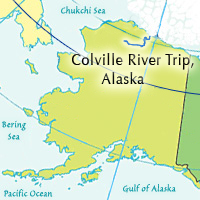Alpine Tundra Yielding to Shrubs
Journal Entry 11: Tuesday, July 29, 2008
COLVILLE RIVER, ALASKA– Another day of fieldwork and floating later, we are camped on a big bend in the Colville, across from cliffs and peregrine falcons. Yesterday saw more science, including clear evidence of shrubs colonizing alpine tundra.
As I mentioned during the first trip, because of the lack of large-scale disturbances like fire, the vegetation up here exists in a delicate equilibrium with climate. When large-scale changes in vegetation are observed, as is the case with the repeat photography covering much of northern Alaska, the changes can be attributed to climate. So, after spending years poring over these old and new photo-pairs, it is exciting to be on the ground, actually seeing the multitude of small new shrubs that collectively signify a sweeping change in vegetation.
Today, we diverted from our sampling protocol to execute a small experiment looking at the relationship between alder shrubs – nitrogen fixers – and adjacent birch and willow shrubs. Many times the alder shrubs have rings or “halos” of birch and willow shrubs encircling them. But why?
Our suspicion is that when the alder colonize new areas, they improve growing conditions for birch and willow shrubs in two ways: First, the alders increase the nitrogen content of the surrounding soil during the summer. And second, during the winter the alders drift snow, providing physical protection and warmer ground temperatures in their immediate vicinity.
To test the nutrient-enhancing capability of alder, we sampled leaves of alder at the center of halos, leaves of birch and willow within the halos, and leaves of birch and willow not located in halos. If the birch and willow leaves within the halo are found to have more nitrogen than in the outlying birch and willow shrubs, then we can confirm that nitrogen from the alder shrub is being utilized by birch and willow.
Today we awoke to 40? F and no bugs. The freedom from constant harassment was rewarding, even after eight hours of paddling in the rain at that temperature. As we broke camp, rain turned to snow, and we ducked into the group tent for a memorable dinner of fried polenta over mac&cheese with re-hydrated mushrooms, sun-dried tomatoes, garlic, and cheddar. Already the conversations are shifting toward food. The question “What’re we having for dinner?” comes earlier every day.












hey lads.
bloody good show.. reallly appreciate the research your conducting..keep up the good work :)
warmest regards
bek